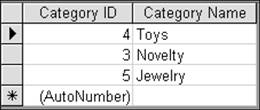SQL
| Let's say your friend is spending the summer in Tokyo. The mailing address he gives you has the text string chome, which in Japanese roughly means "division" or "section." The Japanese post office will have no problem interpreting chome on an envelope you address to him. On the other hand, chome is not Japanese. It only approximates in English the pronunciation of the actual Japanese word, written as Something similar is at work when you add fields, sorts, criteria, and more on the design grid. In the past several pages, I've been telling you to "create a query in Design view." That's not strictly accurate. What I've really been saying is to "use the graphical interface of the design grid to enter characters and symbols that Access can convert into a statement in Structured Query Language (SQL), a database language that Access understands and uses to run a query." Do You Need to Know SQL?If you've opened the drop-down for the View button on the Query Design toolbar, you've likely noticed that one of your choices is SQL. You can view in SQL view any query you create in Design view. It's good to have a little knowledge of SQL to have some appreciation of the language Access understands. Most of the basic queries you'll likely want to make in Access can be created on the design grid without any understanding of SQL. But some queries, such as a union query, must be written in SQL. More important, SQL is the language of relational databases; if you want to do more advanced work in the field, you'll want to have a knowledge of the area. Even if you have no real need for SQL, I don't want you to be so terrified of the term that you can't deal with it on any level. As you saw with the equally daunting normalization in Chapter 3, "Understanding Relationships," at least some aspects of complex and intimidating database subjects are perfectly accessible to nonprofessionals. On the other hand, you're probably aware that "a little knowledge is a dangerous thing." Read the following dip-your-toe-in-the-water discussion in that light as well. To gain a solid understanding of SQL, I recommend SQL Queries for Mere Mortals, by Michael Hernandez and John Viescas (Addison-Wesley, 2000). In this section, you'll learn a few SQL keywords to create a simple query. You'll also use SQL to execute a UNION query, a query type that can be created only in SQL. Quick SQL StartThe key clauses in an SQL statement are listed in Table 8.1.
The first key clause is SELECT. You use it to start the SQL statement and select the field(s) you want in your query. The second key clause is FROM. You use it to tell Access which table(s) contain the fields you specified in the SELECT clause (the SELECT part of the statement). Let's create a very simple query using these two keywords. You'll retrieve records for the first two fields of the Categories table:
Apply a Sort with ORDER BYYou can sort the records by using the keyword ORDER BY. Let's sort by ascending CategoryName:
Add Criteria with WHEREYou use the WHERE clause to add criteria to your SQL statement. The WHERE clause must follow the FROM clause. Suppose you want to select just those categories that begin with the letters G through Z:
Here are the details:
NOTE Don't be surprised or upset if Access modifies your SQL statement when you switch between Design and SQL views. UNION QueriesUsually when you create queries, you want to include various fields from various tables, but you don't want to physically combine them. In a UNION query, you can combine fields with compatible data types (such as text with text, numbers with numbers) in a single column. The fields in the underlying tables remain as they are. For example, imagine that to improve the logistics operations at your firm, you want to do a telephone survey of both suppliers and shippers. The researcher doing the survey asks you for a list of companies and their phone numbers that makes no distinction between suppliers and shippers. You therefore need a list that combines the CompanyName of the Suppliers table with the CompanyName of the Shippers table, and the phone fields of the two tables as well. You can use a UNION query to obtain this information.
|
EAN: 2147483647
Pages: 169
- Chapter VI Web Site Quality and Usability in E-Commerce
- Chapter VII Objective and Perceived Complexity and Their Impacts on Internet Communication
- Chapter IX Extrinsic Plus Intrinsic Human Factors Influencing the Web Usage
- Chapter X Converting Browsers to Buyers: Key Considerations in Designing Business-to-Consumer Web Sites
- Chapter XIV Product Catalog and Shopping Cart Effective Design


